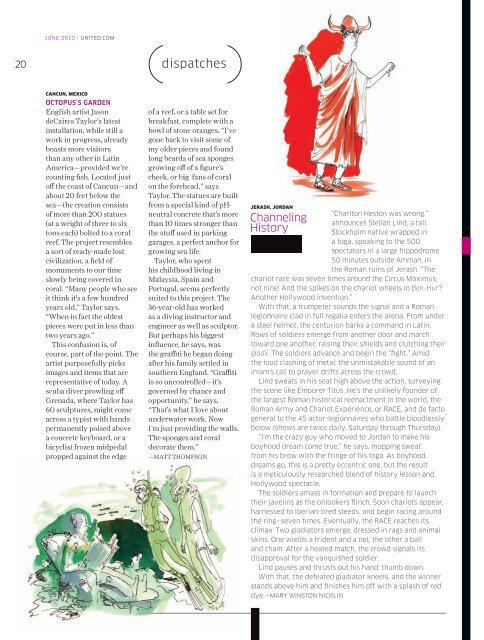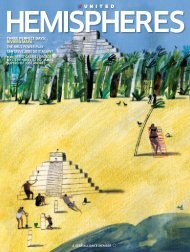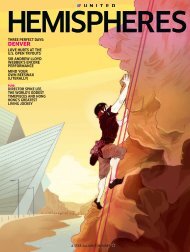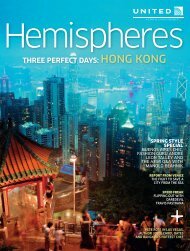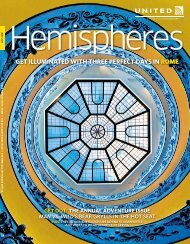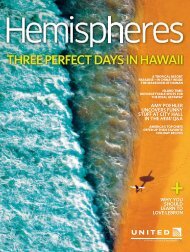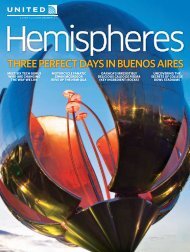june-2010
june-2010
june-2010
You also want an ePaper? Increase the reach of your titles
YUMPU automatically turns print PDFs into web optimized ePapers that Google loves.
20<br />
JUNE <strong>2010</strong> | UNITED.COM<br />
CANCUN, MEXICO<br />
OCTOPUS’S GARDEN<br />
English artist Jason<br />
deCaires Taylor’s latest<br />
installation, while still a<br />
work in progress, already<br />
boasts more visitors<br />
than any other in Latin<br />
America—provided we’re<br />
counting fi sh. Located just<br />
off the coast of Cancun—and<br />
about 20 feet below the<br />
sea—the creation consists<br />
of more than 200 statues<br />
(at a weight of three to six<br />
tons each) bolted to a coral<br />
reef. The project resembles<br />
a sort of ready-made lost<br />
civilization, a fi eld of<br />
monuments to our time<br />
slowly being covered in<br />
coral. “Many people who see<br />
it think it’s a few hundred<br />
years old,” Taylor says.<br />
“When in fact the oldest<br />
pieces were put in less than<br />
two years ago.”<br />
This confusion is, of<br />
course, part of the point. The<br />
artist purposefully picks<br />
images and items that are<br />
representative of today. A<br />
scuba diver prowling off<br />
Grenada, where Taylor has<br />
60 sculptures, might come<br />
across a typist with hands<br />
permanently poised above<br />
a concrete keyboard, or a<br />
bicyclist frozen midpedal<br />
propped against the edge<br />
dispatches<br />
of a reef, or a table set for<br />
breakfast, complete with a<br />
bowl of stone oranges. “I’ve<br />
gone back to visit some of<br />
my older pieces and found<br />
long beards of sea sponges<br />
growing off of a fi gure’s<br />
cheek, or big fans of coral<br />
on the forehead,” says<br />
Taylor. The statues are built<br />
from a special kind of pHneutral<br />
concrete that’s more<br />
than 10 times stronger than<br />
the stuff used in parking<br />
garages, a perfect anchor for<br />
growing sea life.<br />
Taylor, who spent<br />
his childhood living in<br />
Malaysia, Spain and<br />
Portugal, seems perfectly<br />
suited to this project. The<br />
36-year-old has worked<br />
as a diving instructor and<br />
engineer as well as sculptor.<br />
But perhaps his biggest<br />
infl uence, he says, was<br />
the graffi ti he began doing<br />
after his family settled in<br />
southern England. “Graffi ti<br />
is so uncontrolled—it’s<br />
governed by chance and<br />
opportunity,” he says.<br />
“That’s what I love about<br />
underwater work. Now<br />
I’m just providing the walls.<br />
The sponges and coral<br />
decorate them.”<br />
—MATT THOMPSON<br />
JERASH, JORDAN<br />
Channeling<br />
History<br />
“Charlton Heston was wrong,”<br />
announces Stellan Lind, a tall<br />
Stockholm native wrapped in<br />
a toga, speaking to the 500<br />
spectators in a large hippodrome<br />
50 minutes outside Amman, in<br />
the Roman ruins of Jerash. “The<br />
chariot race was seven times around the Circus Maximus,<br />
not nine! And the spikes on the chariot wheels in Ben-Hur?<br />
Another Hollywood invention.”<br />
With that, a trumpeter sounds the signal and a Roman<br />
legionnaire clad in full regalia enters the arena. From under<br />
a steel helmet, the centurion barks a command in Latin.<br />
Rows of soldiers emerge from another door and march<br />
toward one another, raising their shields and clutching their<br />
gladii. The soldiers advance and begin the “fi ght.” Amid<br />
the loud clashing of metal, the unmistakable sound of an<br />
imam’s call to prayer drifts across the crowd.<br />
Lind sweats in his seat high above the action, surveying<br />
the scene like Emporer Titus. He’s the unlikely founder of<br />
the largest Roman historical reenactment in the world, the<br />
Roman Army and Chariot Experience, or RACE, and de facto<br />
general to the 45 actor-legionnaires who battle bloodlessly<br />
below (shows are twice daily, Saturday through Thursday).<br />
“I’m the crazy guy who moved to Jordan to make his<br />
boyhood dream come true,” he says, mopping sweat<br />
from his brow with the fringe of his toga. As boyhood<br />
dreams go, this is a pretty eccentric one, but the result<br />
is a meticulously researched blend of history lesson and<br />
Hollywood spectacle.<br />
The soldiers amass in formation and prepare to launch<br />
their javelins as the onlookers fl inch. Soon chariots appear,<br />
harnessed to Iberian-bred steeds, and begin racing around<br />
the ring—seven times. Eventually, the RACE reaches its<br />
climax: Two gladiators emerge, dressed in rags and animal<br />
skins. One wields a trident and a net, the other a ball<br />
and chain. After a heated match, the crowd signals its<br />
disapproval for the vanquished soldier.<br />
Lind pauses and thrusts out his hand: thumb down.<br />
With that, the defeated gladiator kneels, and the winner<br />
stands above him and fi nishes him off with a splash of red<br />
dye.—MARY WINSTON NICKLIN


